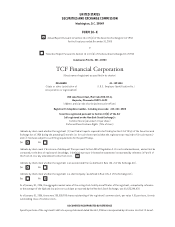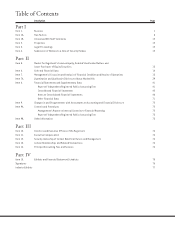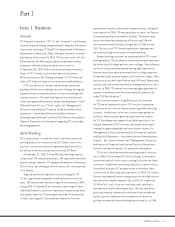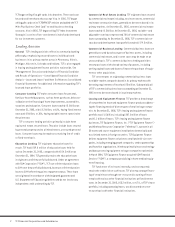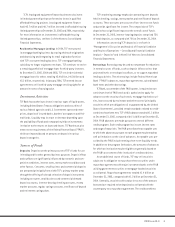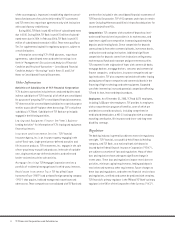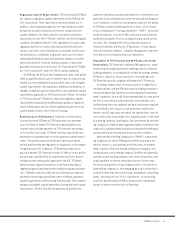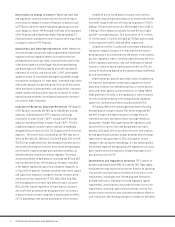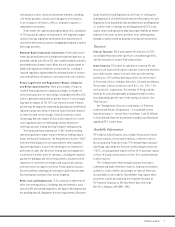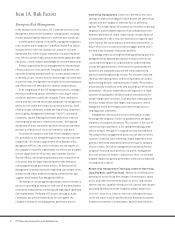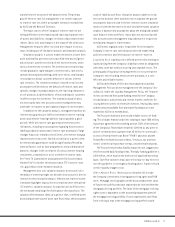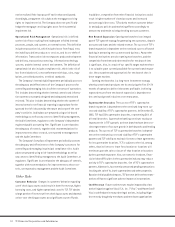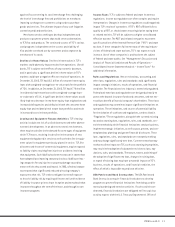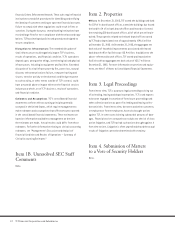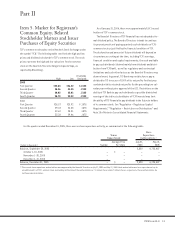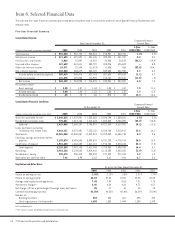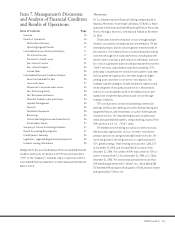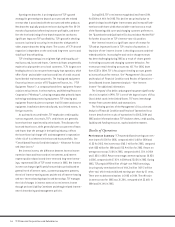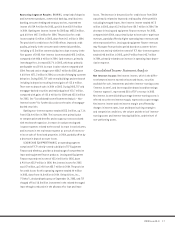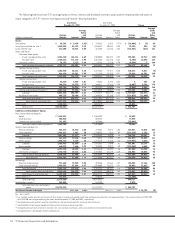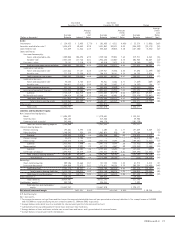TCF Bank 2005 Annual Report Download - page 29
Download and view the complete annual report
Please find page 29 of the 2005 TCF Bank annual report below. You can navigate through the pages in the report by either clicking on the pages listed below, or by using the keyword search tool below to find specific information within the annual report.
92005 Form 10-K
mainly from the structure of the balance sheet. The primary
goal of interest-rate risk management is to control exposure
to interest-rate risk within acceptable tolerances established
by ALCO and the Board of Directors.
The major sources of the Company’s interest-rate risk are
timing differences in the maturity and repricing characteristics
of assets and liabilities, changes in relationships between rate
indices (basis risk) and changes in the shape of the yield curve.
Management measures these risks and their impact in various
ways, including use of simulation analysis and valuation analysis.
Simulation analysis is used to model net interest income from
asset and liability positions over a specified time period (gener-
ally one year), and the sensitivity of net interest income, under
various interest rate scenarios. The interest rate scenarios may
include gradual or rapid changes in interest rates, rate shocks,
spread narrowing and widening, yield curve twists, and changes
in assumptions about customer behavior in various interest
rate scenarios. The simulation analysis is based on various key
assumptions which relate to the behavior of interest rates and
spreads, changes in product balances, the repricing characteris-
tics of products, and the behavior of loan and deposit customers
in different rate environments. The simulation analysis does
not necessarily take into account actions management may
undertake in response to anticipated changes in interest rates.
In addition to the valuation analysis, management utilizes an
interest rate gap measure (difference between interest-earning
assets and interest-bearing liabilities repricing within a given
period). While the interest rate gap measurement has some
limitations, including no assumptions regarding future asset or
liability production and a static interest rate assumption (large
changes may occur related to those items), the interest rate gap
represents the net asset or liability sensitivity at a point in time.
An interest rate gap measure could be significantly affected by
external factors such as loan prepayments, early withdrawals of
deposits, changes in the correlation of various interest-bearing
instruments, competition or a rise or decline in interest rates.
See “Item 7A. Quantitative and Qualitative Disclosures About
Market Risk” for further information about TCF’s interest-rate
risk, gap analysis and simulation analysis.
Management also uses valuation analysis to measure risk in
the balance sheet that might not be taken into account in the net
interest income simulation analysis. Whereas net interest income
simulation highlights exposure over a relatively short time period
(12 months), valuation analysis incorporates all cash flows over
the estimated remaining life of all balance sheet positions. The
valuation of the balance sheet, at a point in time, is defined as the
discounted present value of asset cash flows minus the discounted
value of liability cash flows. Valuation analysis addresses only
the current balance sheet and does not incorporate the growth
assumptions that are used in the net interest income simulation
model. As with the net interest income simulation model, valuation
analysis is based on key assumptions about the timing and variabil-
ity of balance sheet cash flows. It also does not necessarily take
into account actions management may undertake in response to
anticipated changes in interest rates.
ALCO meets regularly and is responsible for reviewing the
Company’s interest rate sensitivity position and establishing
policies to monitor and limit exposure to interest-rate risk.
Liquidity Risk Liquidity risk is defined as the risk to earnings or
capital arising from the Company’s inability to meet its obligations
when they come due without incurring unacceptable losses. The
primary goal of liquidity risk management is to ensure that the
Company’s entire funding needs are met promptly, in a cost-
efficient and reliable manner.
ALCO and the Board of Directors have adopted a Liquidity
Management Policy to direct management of the Company’s liq-
uidity risk. Under the Liquidity Management Policy, the Treasurer
reviews current and forecasted funding needs for the Company
on a daily basis, and periodically reviews market conditions for
issuing debt securities to wholesale investors. Key liquidity ratios
and the amount available from alternative funding sources are
reported to ALCO on a monthly basis.
The Treasurer maintains diverse and reliable sources of fund-
ing. This includes federal funds lines totaling at least $500 million,
repurchase agreement lines totaling at least 150% of the amount
of the Company’s financeable collateral (defined as any piece or
pool of collateral that is greater than $5 million in current par),
access to Federal Home Loan Bank (“FHLB”) advances and the
Federal Reserve Bank discount window, “treasury, tax and loan
notes,” commercial repurchase sweeps, and wholesale deposits.
The Treasurer ensures that liability maturities are staggered to
limit forecasted daily funding needs. The daily funding guideline is
$500 million, which may be met with a mix of approved borrowing
types. Cash flow variances may cause minor day-to-day excesses
over this guideline. A contingency funding plan is in place should
certain liquidity triggers occur.
Other Market Risks Other sources of market risk include
the Company’s investment in mortgage servicing rights and FHLB
stock. Mortgage servicing rights are the discounted present value
of future net cash flows that are expected to be received from the
mortgage servicing portfolio. The value of the mortgage servicing
rights asset is dependent on the assumed prepayment speed of
the mortgage servicing portfolio. Future expected net cash flows
from servicing a loan in the mortgage serving portfolio would


